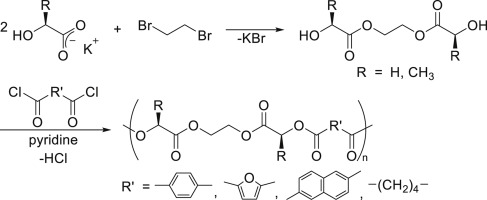Polymer Degradation and Stability ( IF 6.3 ) Pub Date : 2020-01-28 , DOI: 10.1016/j.polymdegradstab.2020.109095 Yuushou Nakayama , Wataru Yagumo , Ryo Tanaka , Takeshi Shiono , Kei Inumaru , Chikara Tsutsumi , Norioki Kawasaki , Naoko Yamano , Atsuyoshi Nakayama

|
Aromatic polyesters such as poly(ethylene terephthalate) (PET), poly(trimethylene terephthalate) (PTT) and poly(butylene terephthalate) (PBT) are widely used all over the world due to their excellent physical properties. However, their degradation in the environment is very slow and the environmental load of their wastes is a potential problem. On the other hand, poly(l-lactic acid) (PLLA) and poly(glycolic acid) (PGA) have attracted attention for their biodegradability. We expected that periodic copolyesters composed of hydroxy acids, ethylene glycol, and terephthalic acid can be biodegradable polymer with relatively high melting points. In this study, a series of novel periodic copolyesters was synthesized and their physical properties and biodegradabilities were investigated. The 2:1 condensation products (LEL and GEG) of l-lactic acid (LA) or glycolic acid (GA) and ethylene glycol were synthesized from the reaction of potassium salt of LA or GA with 1,2-dibromoethane. Then, the polycondensation of LEL or GEG with chloride derivatives of dicarboxylic acids (terephthalic acid, 2,5-furandicarboxylic acid, 2,6-naphthalenedicarboxylic acid, and adipic acid) were performed to produce a series of periodic copolyesters such as poly((ethylene diglycolate) terephthalate) (poly(GEGT)) and poly((ethylene di(l-lactate)) terephthalate) (poly(LELT)). The most of the copolyesters with LA units such as poly(LELT) were amorphous. In contrast, the copolyesters with GA units exhibited relatively high melting temperature (e.g. Tm = 209 °C for poly(GEGT)). The preliminary degradation tests of poly(GEGT) and poly(LELT) were performed. The obtained poly(GEGT) showed biodegradability in seawater at 27 °C.
中文翻译:

由羟基酸,乙二醇和对苯二甲酸组成的周期性共聚酯的合成,性质和生物降解
芳香族聚酯,例如聚对苯二甲酸乙二醇酯(PET),聚对苯二甲酸丙二醇酯(PTT)和聚对苯二甲酸丁二醇酯(PBT),由于其优异的物理性能而在世界范围内广泛使用。但是,它们在环境中的降解非常缓慢,废物的环境负荷是一个潜在的问题。另一方面,poly(l-乳酸(PLLA)和聚乙醇酸(PGA)因其可生物降解性而备受关注。我们期望由羟基酸,乙二醇和对苯二甲酸组成的周期性共聚酯可以是具有相对较高熔点的可生物降解的聚合物。在这项研究中,合成了一系列新型的周期性共聚酯,并研究了它们的物理性质和生物降解性。在2:1的缩合产物(LEL和GEG)的升通过LA或GA的钾盐与1,2-二溴乙烷的反应合成了β-乳酸(LA)或乙醇酸(GA)和乙二醇。然后,将LEL或GEG与二羧酸的氯化物衍生物(对苯二甲酸,2,5-呋喃二甲酸,2,6-萘二甲酸和己二酸)进行缩聚反应,制得一系列周期性的共聚酯,例如聚(( (对苯二甲酸乙二醇酯)对苯二甲酸酯)(聚(GEGT))和对苯二甲酸聚乙二醇酯((对苯二甲酸二(1-乳酸)酯)(聚(LELT))。大多数带有LA单元的共聚酯(例如poly(LELT))是无定形的。相反,具有GA单元的共聚酯表现出较高的熔融温度(例如T m = 209°C(poly(GEGT))。进行了poly(GEGT)和poly(LELT)的初步降解测试。所得的聚(GEGT)在27℃的海水中显示出生物可降解性。


















































 京公网安备 11010802027423号
京公网安备 11010802027423号